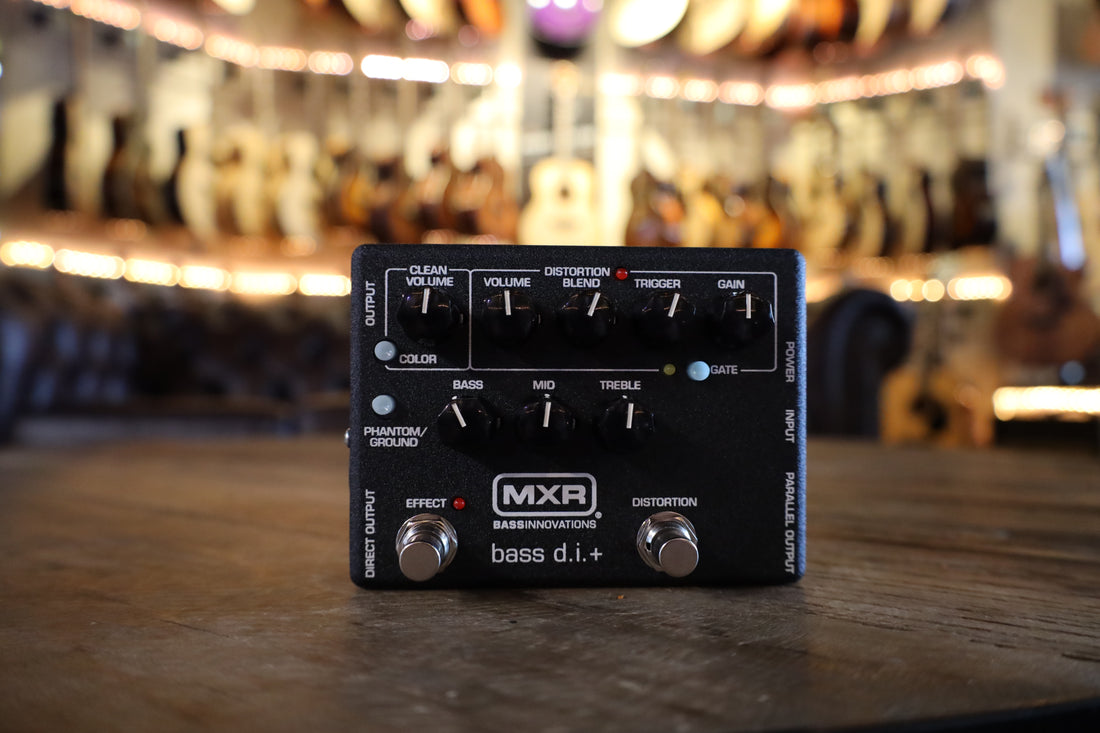Bass Overdrive Pedals: A Comprehensive Review

When it comes to achieving the perfect fuzzy bass tone, having the right pedals is key. In this article, Danville Music’s Adam Schuman and Dave Criss will review and compare some of the top bass overdrive pedals on the market, including overdrive, distortion, and fuzz pedals.
Overdrive Pedals
Let's start by discussing overdrive pedals. Overdrive pedals are designed to simulate the sound of a tube amp being pushed hard, resulting in a slightly distorted and compressed tone. This application will please bass players who want a more “organic” overdriven sound.
Ampeg Bass Scrambler

The first pedal we'll discuss is the Ampeg Bass Scrambler. The Ampeg Bass Scrambler is known for its transparency and subtle edge, which can add just the right amount of grit to your tone.
The pedal also has impressive EQ options that allow for a lot of versatility. This baby can go from subtle overdrive to full-on distortion, and players can adjust the EQ to suit their taste. It’s perfect for the bassist who wants to accurately emulate their amp on the edge of exploding!
Green Rhino

The second pedal we'll look at is the Green Rhino. This pedal is a great “tube screamer” style pedal, and the Green Rhino circuit is very popular with guitarists (most notably Mike Campbell, whose tone is admired by musicians around the world).
Despite being marketed as a guitar pedal, the Green Rhino MK IV can be used effectively for bass. It offers additional EQ options and a toggle switch to add 100Hz, allowing bassists to retain their low end while still achieving a crunchy overdriven tone.
Adam and Dave appreciate the pedal's ability to retain the low end, making it a versatile option for bass players. The pedal is particularly effective when used with active pickups.
Distortion Pedals
Distortion pedals are similar to overdrive pedals but offer a more pronounced distorted effect. They are perfect for players who want a more aggressive, hard-hitting tone.
MXR Bass Distortion

The first pedal we will discuss is the MXR Bass Distortion. As the name suggests, this pedal is specifically designed for bass and offers a range of distortion options, from mild overdrive to heavy distortion.
Adam and Dave were impressed that the pedal is capable of producing a wide range of tones, and they appreciate the versatility of the pedal. The pedal's blend knob allows players to dial in the perfect mix of clean and distorted tones, and the EQ options allow for a lot of flexibility.
Adam notes that the pedal works particularly well with active pickups, and Dave appreciates the pedal's ability to cut through the mix in a live setting.
MXR Bass DI Plus

The second distortion pedal we'll review is the MXR Bass DI Plus.
This pedal offers a thick, aggressive tone and can be used as both a distortion pedal and a DI box, making it a versatile addition to any bassist's setup.
According to Dave and Adam, the pedal's distortion is thick and full, with a lot of sustain. They both appreciate the pedal's ability to add low end while still maintaining clarity, and they note that the pedal is perfect for players looking for a thick, aggressive tone.
Dave also notes that the pedal's DI functionality is well suited for both live and studio performances.
Fuzz Pedals

Fuzz pedals are known for their distinct, fuzzy sound and are popular among bass players looking to achieve a thick, saturated tone.
Electro-Harmonix Big Muff
The Electro-Harmonix Big Muff is one of the most popular and iconic fuzz pedals on the market. Originally designed for guitar, the bass version of the Big Muff offers a lower frequency range that makes it perfect for bass.
This pedal can add a unique, almost synth-like quality to your tone and is perfect for players who want to stand out in the mix. We also appreciate the pedal's ability to dial in a range of different fuzz tones, from subtle to all-out nastiness.
Conclusion
In conclusion, choosing the right overdrive, distortion, or fuzz pedal can make a huge difference in your bass tone. By trying out different pedals and finding the one that works best for you, you can take your bass sound to the next level. Whether you're looking for a subtle edge or an all-out distorted tone, there are a variety of pedals on the market to suit your needs.
It's worth noting that the pedals we reviewed are just the tip of the iceberg. There are many other pedals available on the market, and what works best for one player might not work as well for another. That said, we hope that this article has provided you with some helpful insights into the world of bass overdrive pedals.
In the end, the most important thing is to experiment and find the pedal that works best for you and your playing style. Whether you're looking for a subtle edge or a full-on fuzz tone, there's a pedal out there that can help you achieve the sound you're after.
So, get out there, try some pedals, and take your bass sound to the next level!
Trending Posts
Recent Posts
Best Guitar Amps Under $1000 for 2025
December 09, 2025
Best Guitars Under $500: Expert Picks for 2025
November 20, 2025


 Adam Schuman
Adam Schuman




